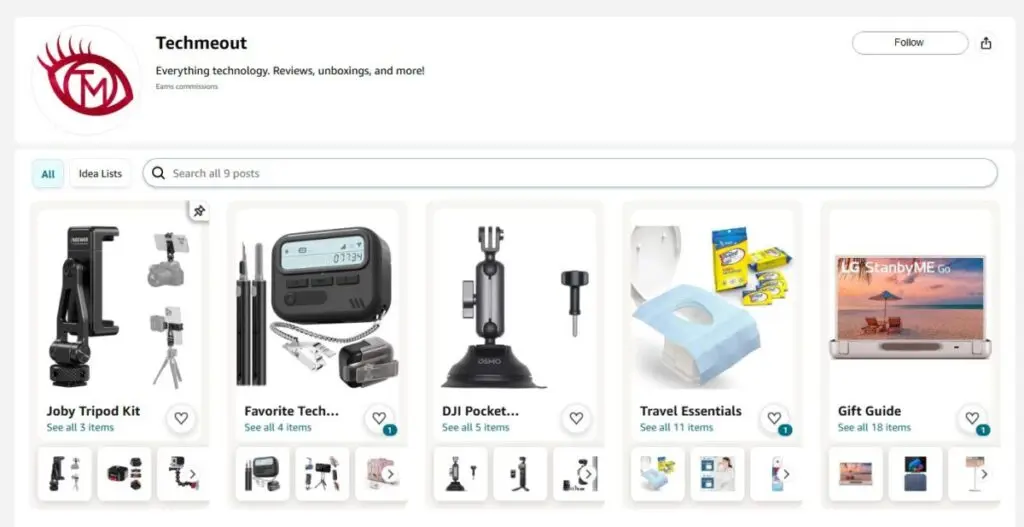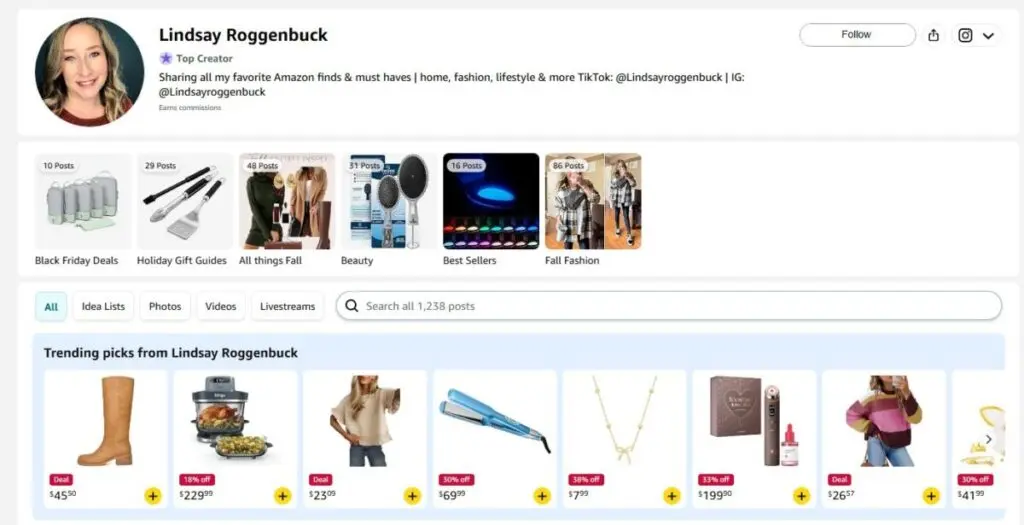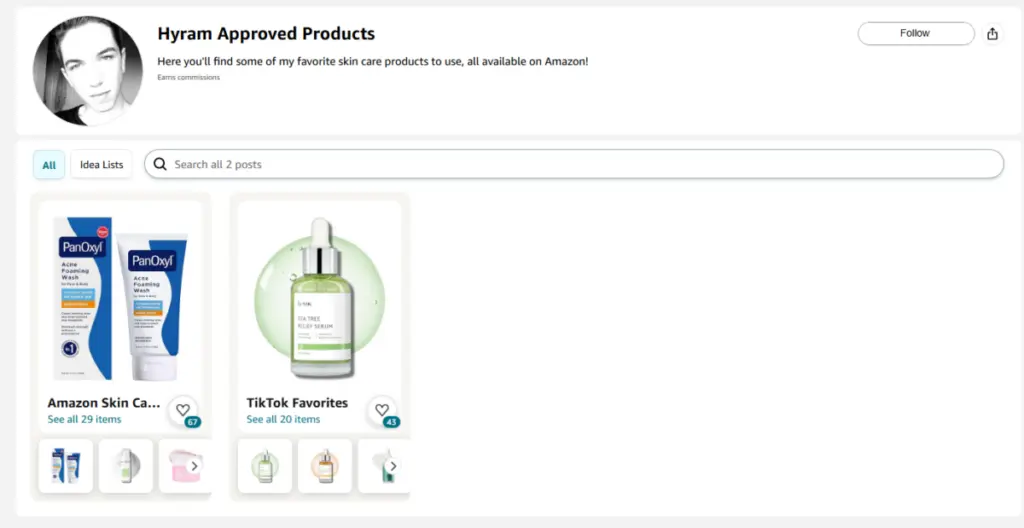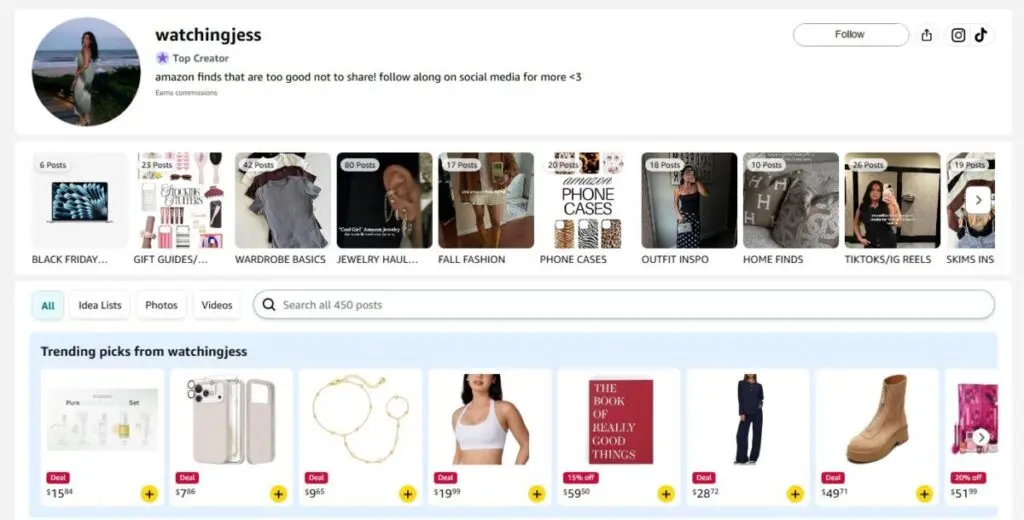The Amazon Creator Hub has become one of the most important earning engines for influencers. As more creators look for stable monetization beyond unpredictable social algorithms, two questions keep surfacing:
- How do you get discovered by brands on Amazon
- What type of content actually converts shoppers?
These questions reflect a broader shift in how audiences make purchase decisions. With 92% of consumers trusting personal recommendations from micro influencers, Amazon’s commerce ecosystem is now perfectly aligned with what shoppers already prefer — authentic, product-tested content.
Across TikTok, YouTube, and Instagram, creators are turning to Amazon because the Creator Hub environment offers predictable commissions, built-in brand deals, and a high-intent audience already primed to buy.
As short shoppable videos, livestream shopping, and Amazon-native collaborations continue to expand, one pattern is undeniable: creators who understand how the Amazon Influencer Creator Hub works grow faster and earn more consistently than those relying on social virality alone.
What the Amazon Creator Hub Is in 2025
The Amazon Creator Hub is Amazon’s unified workspace for influencers, product reviewers, streamers, and social-first creators who want to earn revenue from shoppable videos, livestreams, and branded collaborations.
In 2025, the Hub consolidates tools that were previously spread across the Amazon Influencer dashboard, Amazon Live Creator app, and Creator Connections system, making Creator Hub the central command center for content publishing and brand deal management.
Over the past two years, Amazon has invested heavily in creator ecosystems in response to rising competition from TikTok Shop and Walmart Creator. This has led to the rollout of new analytics panels, upgraded brand-match tools, and storefront customization that help creators streamline how they publish, track, and monetize content.
For influencers who previously used Amazon Associates alone, the Hub now offers a more advanced infrastructure with better video placement opportunities and higher-intent visibility.
@nicholettesjames Start reviewing everything in your home! #amazoningluencerprogram #amazoninfluencer #influencertips
How the Amazon Influencer Creator Hub Works
The Amazon Influencer Creator Hub serves as both a publishing system and an earnings engine. Creators can upload shoppable videos and product photos, manage Idea Lists, customize their storefront layout, join Creator Connections campaigns, and view performance insights in real time.
One of the most impactful upgrades in 2025 is that videos published through the Hub now surface across a wider array of placements: detail pages, search results, editorial recommendation modules, and even in Amazon Live replays. This change directly benefits creators who post consistent how-to, comparison, and POV demo content.
How Amazon’s Expansion Shaped the Modern Hub
Beginning in late 2023, Amazon started integrating Creator Connections — its internal brand-collab marketplace — directly into the influencer dashboard. By 2025, creators can now receive campaign invitations, negotiate deliverables, upload content, and receive payment through a single workflow inside Creator Hub.
Amazon also revamped its review and compliance systems. This includes stricter rules on prohibited claims in categories like supplements and skincare, improved auto-flagging of AI-generated content that lacks disclosure, and enhanced moderation for misleading “before/after” visual comparisons.
These updates align the Hub with broader platform-level safety expectations, similar to what YouTube introduced with its 2024 AI-content labeling policy.
Who the Amazon Creator Hub Is Designed For
Although often associated with classic product reviewers, the 2025 Hub supports multiple creator types: lifestyle TikTokers, YouTubers, livestream hosts, niche hobbyists, beauty reviewers, and micro-influencers with under 10k followers who specialize in specific product categories.
Eligibility Criteria and Account Setup
The Amazon Creator Hub streamlines the sign-up and onboarding process for influencers, but approval still depends on meeting Amazon’s platform-quality benchmarks.
The onboarding path is more structured than the early Influencer Program era, and creators must show evidence of consistent, authentic content before being accepted. Understanding eligibility — and preparing your profiles in advance — significantly improves your chances of approval.
Eligibility Requirements for 2025
To join Creator Hub Amazon, influencers must have active, public accounts on at least one supported platform: TikTok, YouTube, Instagram, or Facebook.
The most successful applicants tend to fall into one of three groups:
1. Review and Recommendation Creators
These are channels focused on unboxings, try-ons, demos, and buyer guides. A real example is TechMeOut, a tech reviewer whose YouTube content consistently aligns with Amazon’s category guidelines. Her audience expects reliable product breakdowns, which signals to Amazon that she can drive high-intent traffic.
2. Niche Category Experts
Creators who specialize in a clear vertical — like home organization, beauty, or automotive accessories — often see faster approvals. Amazon’s systems reward topic authority because it correlates with better conversion rates.
3. Livestream-Ready Creators
Amazon Live has grown significantly from 2023 to 2025, and creators who already stream on YouTube or TikTok are considered strong candidates.
In all cases, content must comply with platform policies and not contain misinformation, unsafe recommendations, misleading claims, or prohibited content categories. Repeated violations on other platforms can lead to automatic rejection inside the Amazon Influencer Creator Hub.
Preparing Your Social Profiles Before Applying
Amazon conducts a manual and automated review of creator profiles. Before applying, ensure your feeds demonstrate:
- A recurring content theme, not scattered posting
- Clear evidence of product-relevant content
- Authentic reviews or lifestyle integration
- No engagement manipulation, AI spam, or bot patterns
You should also make sure your bio clearly states your creator role. For instance, creators who list themselves as “tech reviewer,” “home finds creator,” or “beauty tester” typically receive smoother approvals than creators with vague or unrelated bios.
Step-by-Step Account Setup
Once your social profiles are ready, onboarding through Creator Hub Amazon follows this sequence:
1. Sign in with your Amazon account
Use an account free of past policy violations. Amazon checks this automatically.
2. Connect your primary social profile
You’ll authenticate one platform first. After approval, you can add others.
3. Complete the tax and payment sections
This includes W-9 or W-8BEN information, bank details, and region-specific documentation.
4. Customize your storefront
Inside the Amazon Influencer Creator Hub, you’ll set up your display name, profile photo, cover image, and bio. This storefront becomes your public-facing Amazon destination.
5. Upload your first shoppable video
Amazon favors creators who publish early. Many newly approved creators see faster indexing when they upload a simple review or comparison clip within the first week.
Common Rejection Reasons
The most frequent causes of rejection in 2025 include:
- Low-quality or inconsistent content
- Lack of product-focused posts
- Private or restricted social profiles
- Violations on TikTok, YouTube, or Instagram
- Misleading niche claims or AI-generated spam
Creators who receive a rejection can reapply after improving their content. Many succeed on the second attempt after posting several high-quality review or demonstration videos.
Understanding Revenue Streams Inside Creator Hub
The Amazon Creator Hub offers one of the most diversified earning ecosystems for creators. Unlike platforms where monetization depends primarily on brand deals or ad revenue sharing, Amazon provides multiple parallel income streams that reward different types of content, from short product demos to livestream shopping.
Inside Creator Hub, Amazon creators can combine commissions, brand partnerships, bonuses, and seasonal incentives into a layered earnings strategy that scales with content output and niche authority.
Commission Structures for 2025
Amazon’s commission rates remain category-based, with percentages varying widely between high-inventory household categories and lower-margin electronics. Beauty, fashion, and home essentials often deliver some of the strongest conversion performance because shoppers purchase repeatedly — an important factor since creators earn each time a tagged shopper buys.
Creators like Lindsay Roggenbuck, whose TikTok videos routinely drive viral product sellouts, have demonstrated how discovery-based content can outperform even large follower counts. Her storefront activity shows consistent ranking across detail pages, which directly fuels ongoing commission revenue.
This is one of the most attractive aspects of the Amazon Influencer Creator Hub: well-performing videos continue earning long after they are published.
Creator Connections: Paid Brand Collaborations Within Amazon
Creator Connections is Amazon’s internal marketplace where brands post paid campaign briefs. This is the closest Amazon has to a closed creator marketplace, and in 2025, it has expanded significantly.
Inside Creator Hub, Amazon creators can:
- Apply for campaign opportunities
- Receive invitations from brands
- Upload deliverables
- Review contracts and content usage terms
- Receive payment directly inside the system
Campaigns typically require shoppable videos, curated lists, or product demos. The marketplace now includes mid-size brands and several notable DTC brands that migrated to Amazon listings, further increasing deal flow.
Usage rights are a major component. Brands may request to use your Amazon videos in Sponsored Brands Video campaigns or in DSP (Demand-Side Platform) retargeting. Usage fees are usually handled inside Creator Connections rather than through off-platform negotiation, giving creators more clarity and protection.
Seasonal Bonuses and Performance Incentives
Seasonal bonuses are a substantial income driver within the Amazon Creator Hub. During peak periods like Prime Day, Back-to-School, and Q4 holidays, Amazon runs category-specific incentives that reward creators for increased publishing cadence or for driving traffic to seasonal deal pages.
Amazon also offers recurring “Onsite Video Performance” bonuses for creators whose clips appear on multiple high-traffic product pages. These bonus programs favor creators who publish frequently and maintain strong video quality standards.
Livestream Earnings and Conversion Advantages
Amazon Live remains a differentiator. Livestream creators can earn through:
- Standard commissions
- Creator Connections sponsorships
- Exclusive livestream bonuses
- Higher conversion rates from live demonstrations
Livestream content also lives on as shoppable replays, creating long-tail earnings inside the Amazon Influencer Creator Hub.
How to Get Brand Deals Through Creator Connections
Brand collaborations inside the Amazon Creator Hub are powered by Creator Connections, Amazon’s internal marketplace where brands and influencers work together through a structured, native workflow.
For influencers who previously relied on off-platform outreach, Creator Connections offers a far more predictable way to access paid opportunities, negotiate usage, and streamline deliverables.
How Creator Connections Works Inside Creator Hub Amazon
Creator Connections operates similarly to closed creator marketplaces like TikTok Creator Marketplace or Instagram’s Brand Collabs Manager, but is unique because brands are already Amazon sellers.
That means the creator’s content directly influences sales within Amazon’s ecosystem, making performance easier to track and value.
Within Creator Hub Amazon, creators can:
- Browse open campaigns based on niche
- Receive direct invitations from brands
- View campaign budgets, product categories, and deliverable requirements
- Accept or negotiate terms
- Submit content for approval
- Track payment status
- Access campaign analytics once content is published
Amazon prioritizes creators who have strong storefront activity, consistent shoppable videos, and historically high conversion rates. This ensures brands are paired with creators who can reliably drive purchase behavior.
What Brands Look for in Applicants
Brands posting campaigns in Creator Connections generally prioritize creators who demonstrate:
- Clear niche alignment
- High-quality shoppable videos
- Clean compliance history
- Transparent product testing
- Strong on-camera presence
- Consistent cross-platform content
For example, beauty and skincare brands typically gravitate toward creators like Hyram, known for evidence-based product reviews on TikTok. His content demonstrates ingredient-level knowledge and transparency, which aligns with Amazon’s heightened safety and compliance expectations in sensitive categories.
Brands also evaluate your past Amazon performance. Creators with videos ranking on multiple product pages tend to receive more invitations because Amazon’s algorithm signals their ability to influence shopper decisions.
Producing High-Converting Amazon Content
Creating high-performing content inside the Amazon Creator Hub requires more than simply showcasing a product. Amazon rewards creators who answer buyer questions, demonstrate real-world performance, and publish consistently across categories.
The platform’s ranking system gives priority to videos that reduce customer hesitation, especially in high-return categories like home gadgets, small appliances, and beauty tools. When content guides shoppers to an informed decision, Amazon surfaces it more widely across product detail pages and search results.
Product Research That Identifies High-Intent Opportunities
Strong Amazon content begins before you ever hit record. Browsing Best Sellers and Movers and Shakers helps creators understand which products shoppers are already searching for, but the most successful creators go deeper by analyzing repeat demand, seasonal patterns, and gaps in existing review videos.
A notable example is Watching Jess, whose Amazon reviews consistently rank among the top-selling fashion and beauty products. Her strength lies in selecting items already in high-intent shopping cycles.
She often publishes videos for products that surge during seasonal trends, allowing her content to ride existing demand rather than trying to manufacture interest.
Creators inside the Creator Hub at Amazon have an advantage because they can track how their videos perform across multiple placements. Over time, this data reveals which product categories convert most reliably for their audience, creating a content strategy rooted in evidence instead of guesswork.
Shoppable Video Standards That Amazon Prioritizes
Amazon heavily favors videos that are short, factual, and visually clear. In 2025, the average top-ranking product video is under 60 seconds, with a direct explanation of how the item works followed by a concise takeaway.
This approach works well inside the Amazon Influencer Creator Hub because shoppers want straightforward clarity rather than entertainment-driven storytelling.
Video success also depends on avoiding restricted claims, especially in skincare, supplements, and wellness categories. Amazon’s automated moderation now flags unverified medical claims, AI-generated misinformation, and deceptive “before/after” visuals. Sticking to measurable, observable demonstrations ensures videos pass compliance quickly and maintain long-term visibility.
Livestream Strategy for Higher Conversion
Livestreams inside Creator Hub continue to deliver some of the highest conversion rates across the platform. They mimic the real-time trust builders of QVC-style demos while offering interactive chat and direct product pinning.
Livestream replays also become evergreen shoppable content on Amazon, compounding traffic long after the broadcast ends. When creators integrate pre-show promotion on TikTok or Instagram with consistent streaming on Amazon Live, their visibility in the Amazon Creator Hub grows significantly.
Level Up Your Earning Power Inside the Amazon Creator Hub
The Amazon Creator Hub has become one of the most powerful ecosystems for influencers who want to turn authentic product recommendations into real income. Whether creators join through Creator Hub Amazon for commissions, brand deals, or livestream conversions, the platform now offers a unified space to publish, optimize, and scale shoppable content without relying solely on external social algorithms.
By understanding how the Amazon Influencer Creator Hub works, from eligibility and onboarding to content strategy and campaign opportunities, creators can build a sustainable, long-term revenue engine rooted in trust and consistent performance.
With Amazon continuing to expand placements, analytics, and creator matchmaking, the next wave of influencers who win on Amazon will be those who stay strategic, compliant, and product-focused.
Frequently Asked Questions
How does the Amazon Creator Hub differ from the regular Amazon Associates program?
The Amazon Creator Hub is built for influencers who publish on-site videos and storefront content, while the Associates program focuses on referral linking workflows commonly used in Amazon Associate marketing.
Can creators use external tools to improve their Amazon workflow?
Yes, many influencers streamline product research and link management with specialized Amazon affiliate marketing tools that help identify high-intent products faster.
Do DTC brands collaborate with creators through Amazon?
More direct-to-consumer companies now run creator campaigns on Amazon, especially as they adopt strategies used by successful DTC brands on Amazon to boost product visibility.
Does AI affect how creator videos are discovered on Amazon?
AI is increasingly shaping search and ad placements, and brands using advanced Amazon AI advertising often generate higher product demand that benefits creator content.
Is knowledge of PPC helpful for influencers joining Creator Connections?
Understanding how sellers manage bids and placements through Amazon PPC training can make creators more effective partners in performance-driven campaigns.
Can creators take part in Amazon product launches?
Yes, brands frequently involve influencers when executing coordinated releases modeled on proven Amazon product launch strategy techniques.
Do creators need familiarity with Amazon’s broader marketing ecosystem?
Not required, but creators who understand how brands structure campaigns using Amazon marketing services often negotiate clearer deliverables and usage expectations.
Is it possible to combine the Creator Hub with off-site affiliate content?
Many influencers blend on-site videos with external channels that use traditional Amazon affiliate marketing to diversify traffic and strengthen conversion funnels.







